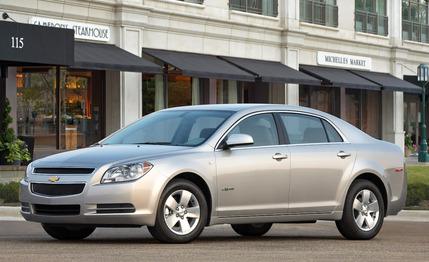 Review
Review
Introduction
For 2009, Chevrolet is releasing a slightly revised Malibu hybrid that boasts improved fuel economy without adding much to the sticker price. Last year Chevy unveiled the redesigned Malibu (click here for information on the 2009 Malibu), which bears little resemblance to the appliance-like models of the past few years. Although the new Malibu is still built on the same platform as the previous version, the body and the interior are completely new. The exterior styling is modern, distinctive, and more stylish than anything else in a Chevy showroom. The interior design is similarly well executed—a flowing instrument panel features gauges and controls that are easy to decipher and use. Most interior plastics have a rich graining and are soft to the touch. Available only as a sedan, the Malibu rides on the long-wheelbase version of GM’s front-wheel-drive Epsilon platform. The long, 112.3-inch wheelbase gives the Malibu a spacious back seat with plenty of legroom.
For its fuel-sipping hybrid model, Chevy starts with the Malibu’s four-cylinder engine and adds electric assistance and a stop/start system. The stop/start system works by shutting off the gasoline engine when the car is stopped. To restart, all the driver has to do is lift off the brake pedal, and the electric motor/generator brings the gasoline engine to life. Chevy claims the electric motor can offer some assistance to the gasoline engine in full-throttle situations, but the Malibu’s system is what is known as a “mild” hybrid, as the electric motor can’t move the car down the road on its own. Some of the Malibu hybrid’s competition have more-sophisticated hybrid systems that can propel the car on electric power alone, but an upside of the GM system is that it doesn’t cost as much money.
There’s no need to plug in the Malibu hybrid, as the car automatically charges its battery pack by recapturing the energy from deceleration or braking. If not enough energy is returned to the battery pack, the gasoline engine will work to charge the battery pack. In hybrid models, the DOHC 2.4-liter four-cylinder engine produces 164 horsepower and comes exclusively with a four-speed automatic. The EPA estimates fuel economy of 26 mpg city and 34 highway; for comparison purposes, a four-cylinder Malibu with a six-speed automatic boasts EPA numbers of 22 city and 33 highway.
Major fuel-miser competitors to the Malibu hybrid include the Nissan Altima hybrid, Saturn Aura hybrid, Toyota Camry hybrid, Toyota Prius, and Volkswagen Jetta diesel. Except for the mechanically similar Aura hybrid, all are more efficient.
Verdict
The Malibu hybrid gets the great looks, refined dynamics, and handsome interior of the standard Malibu, and it offers excellent fuel economy for a family sedan. However, it might take some time for die-hard import buyers to be convinced that the Malibu hybrid is serious competition to the hybrid models from Toyota and Nissan.
Click here to read our full review of the Chevrolet Malibu hybrid.
What’s New for 2009
Thanks to lower-rolling-resistance tires and revised control of the battery-charging system, the Malibu hybrid gets slightly better fuel economy for 2009. Other changes include a new 17-inch wheel design and several new exterior paint colors.
Highlights and Recommendations
The Malibu hybrid comes well equipped and offers only a few options. If you’re looking into the Malibu hybrid, seriously examine your driving habits and whether the benefit of a few mpg is worth the extra cost of the hybrid model (roughly $4000 over the least-expensive regular Malibu) before proceeding.
Safety
Dual front airbags, front-seat-mounted side-impact airbags, curtain airbags, front-seatbelt pretensioners, tire-pressure monitoring, anti-lock brakes, traction control, StabiliTrak stability control, and OnStar emergency services are all standard on the Malibu hybrid.